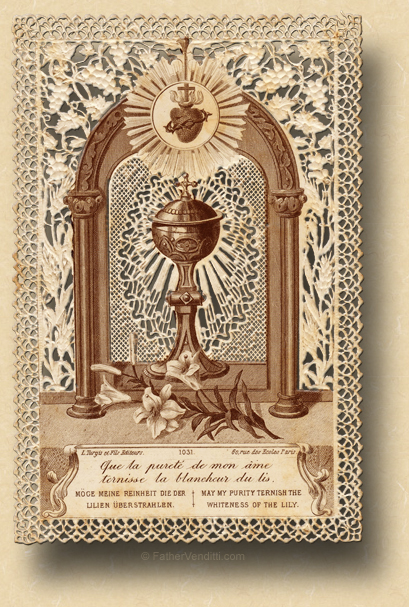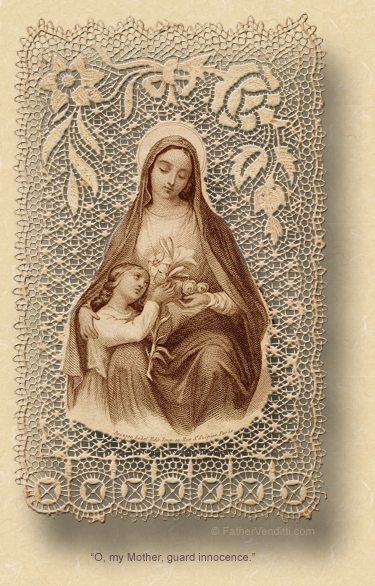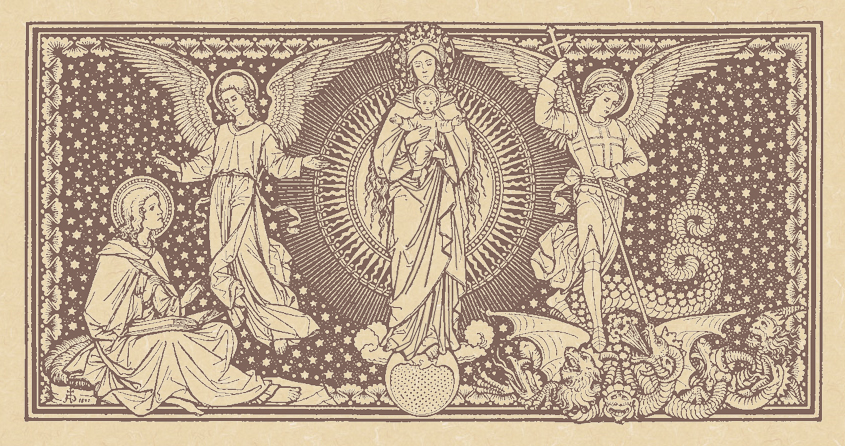An Inconvenient Truth.
The Memorial of Saint Charles Lwanga & Companions, Martyrs.
Lessons from the feria, according to the ordinary form of the Roman Rite:
• Acts 28: 16-20, 30-31.
• Psalm 11: 4-5, 7.
• John 21: 20-25.
|
…or, from the proper:
• Maccabees 7: 1-2, 9-14.
• Psalm 124: 2-5, 7-8.
• Matthew 5: 1-12.
…or, any lessons from the common of Several Martyrs in Easter Time.
|
The Vigil of Whitsunday.*
Lessons from the feria, according to the extraordinary form of the Roman Rite:
• Acts 19: 1-8.
• [The Gradual is omitted.]
• John 14: 15-21.
The Fifth All Souls Saturday.**
First & third lessons from the pentecostarion, second & fourth from the menaion for the dead, according to the Ruthenian recension of the Byzantine Rite:
• Acts 28: 1-31.
• I Thessalonians 4: 13-17.
• John 21: 15-25.
• John 5: 24-30.
FatherVenditti.com
|
 6:54 AM 6/3/2017 — By this time you’ve figured out that Father James, who was advertised to be here today on this First Saturday of June, could not be with us, called away at the last minute by parish duties, which means that the task falls to me with very little time to prepare. 6:54 AM 6/3/2017 — By this time you’ve figured out that Father James, who was advertised to be here today on this First Saturday of June, could not be with us, called away at the last minute by parish duties, which means that the task falls to me with very little time to prepare.
We begin with recognizing the importance of the saints commemorated in today’s memorial, the story of whom is only very generally known, probably because it’s a very politically incorrect story. In the late 19th century, the king of Uganda launched a vicious persecution of the Church in his country in response, mostly, to the Church’s open hostility to the culture of corruption and homosexuality that surrounded King Mwanga’s court. Charles Lwanga was the master of the king’s pages, and was also a Catholic who persuaded the young pages of whom he had charge to refuse the homosexual advances of the king and his courtiers. As a result, he and fourteen of his fellow pages were put to death on June 3rd, 1886, with many more Ugandan Catholics in the persecution which followed for a full year. Saint Charles himself is the patron saint of the African Catholic Youth Action movement, though he should really be the patron saint of the purity of the young, along with Maria Goretti, since that’s what he died for.
Which is not necessarily a bad introduction to what was supposed to be the topic of our First Saturday consideration today: making reparation for outrages committed against the Perpetual Virginity of the Mother of God. The Perpetual Virginity of Mary is, of course, a dogma of the faith—we all know that—but what exactly does it mean? It’s means, quite simply, that Mary remained a virgin before, during and after the birth of our Blessed Lord. From the first three centuries on, Fathers and Doctors of the Church, Theologians and mystics and dogmatists have tried to figure out exactly what that means. Does it refer to actual physical integrity, or does it simply mean that our Blessed Mother had no relations with any man? Personally, I like to cling to the explanation given by the last of the great Fathers of the Church, Saint John Damascene, who died in 749: he said that Jesus passed through the womb of His Blessed Mother in much the same way that light passes through a window.
But however you choose to interpret the dogma of our Blessed Mother’s perpetual virginity, She Herself clearly identified this to Sister Lucia as a target of many blasphemies for which She instructed us to make reparation. And I suppose the first way in which this dogma is blasphemed is in simply denying it. I encountered this myself as a very young man. I attended a high school run by the Augustinian Fathers in Washington, DC, and, upon graduation I moved on to Villanova University to pursue that vocation; and, whenever I had occasion to visit Washington I stayed at the priory connected to the school I had attended. And one afternoon, an Augustinian Father from another priory was visiting that day. He was an older man, one of those unfortunate creatures who had been left shell-shocked from the turmoil of the Second Vatican Council, totally confused about what he believed.  And in the course of the table conversation the prior of the house asked him whether he believed in the virginity of the Blessed Virgin Mary, and he said quite candidly, “No.” He didn’t believe anymore in such fair tales, that he was certain it must have been a passing Roman soldier who did the deed. That experience was not the only reason I decided not to persevere in a vocation with the Augustinian Fathers, but it did begin the process of questioning whether I was going down the right path. A couple of years ago an Augustinian priest I had known quite well in high school passed away, and I returned to the mother house at Villanova to attend his funeral, and was thoroughly confirmed that I had made the right decision to pursue a vocation in the secular priesthood instead. And in the course of the table conversation the prior of the house asked him whether he believed in the virginity of the Blessed Virgin Mary, and he said quite candidly, “No.” He didn’t believe anymore in such fair tales, that he was certain it must have been a passing Roman soldier who did the deed. That experience was not the only reason I decided not to persevere in a vocation with the Augustinian Fathers, but it did begin the process of questioning whether I was going down the right path. A couple of years ago an Augustinian priest I had known quite well in high school passed away, and I returned to the mother house at Villanova to attend his funeral, and was thoroughly confirmed that I had made the right decision to pursue a vocation in the secular priesthood instead.
But the perpetual virginity of the Mother of God is blasphemed not simply by those who deny it, but in every attack on holy purity we see in our society today. Those of you who know me well know I have a thriving Internet ministry, through my own website where my homilies are posted for all to read, and my Facebook page which reaches hundreds every week. According to my Internet service provider, my homilies are seen in over sixty different countries on a daily basis. And, yet, I also hear confessions every day, and I’m not breaking any seal of confession in telling you that the most commonly confessed sin today is the viewing of Internet pornography accompanied by self-abuse, by both the single and the married, and by women equally along with men. The Devil knows well how to use the means at his disposal.
So, when the Mother of God asks us, through Sister Lucia, to make reparation for outrages committed against Her Perpetual Virginity, we should have little reason to ask why. The Perpetual Virginity of our Lady is also a testimony to the Divinity of Christ, Who had a human Mother conceived without sin, but Who had no human father. So, questioning or denying the Virginity of the Mother of God is to deny that Christ is God.
This evening, with the Vigil of Pentecost, the Easter Season comes to a close, and today’s Gospel lesson is the Blessed Apostle John’s own signature to his long life in service to our Lord. He recounts an almost mystic conversation in which he, himself, is the topic, in which Peter questions our Lord about John, already suspecting that John would be the only one of our Lord’s disciples not to die a martyr’s death. Our Lord’s response to Peter is important: “If it is my will that he should wait till I come, what is it to thee? Do thou follow me” (John 21: 22 Knox). That command is given not only to Peter but to us all. We should not distract ourselves with the world and its pleasures, or what we may think we’re missing out on in not following the ways of the world. With our eyes facing forward, we should simply follow Him.

* In the extraordinary form, the word “vigil” designates the entire day before a First Class Feast, and the Mass on that day takes place in the morning. The texts and lessons, while proper to the vigil, are always different from that of the feast itself, and no obligation is satisfied.
"Whitsunday" is nothing more than an anglicized name for Pentecost. Most editions of the Missal of St. John XXIII produced for use in English speaking countries use the title, but still refer to the octave and season following as those of Pentecost. In non-English speaking countries, the title "Whitsunday" is unknown. See the post for tomorrow's homily for Pentecost Sunday for more information.
** While the Western Church commemorates the Holy Souls once a year on November 2nd, the Churches of the Byzantine Tradition do so five times a year: once during the Triodion, three times during the Lenten season and once during the Paschal season, always on a Saturday; these are called the All Souls Saturdays.
|

